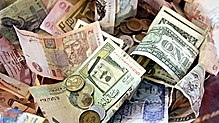Our website is made possible by displaying online advertisements to our visitors.
Please consider supporting us by disabling your ad blocker.
Currency intervention
| Foreign exchange |
|---|
| Exchange rates |
| Markets |
| Assets |
| Historical agreements |
| See also |


Currency intervention, also known as foreign exchange market intervention or currency manipulation, is a monetary policy operation. It occurs when a government or central bank buys or sells foreign currency in exchange for its own domestic currency, generally with the intention of influencing the exchange rate and trade policy.
Policymakers may intervene in foreign exchange markets in order to advance a variety of economic objectives: controlling inflation, maintaining competitiveness, or maintaining financial stability. The precise objectives are likely to depend on the stage of a country's development, the degree of financial market development and international integration, and the country's overall vulnerability to shocks, among other factors.[1]
The most complete type of currency intervention is the imposition of a fixed exchange rate with respect to some other currency or to a weighted average of some other currencies.
- ^ Joseph E. Gagnon, “Policy Brief 12-19”, Peterson Institute for International Economic, 2012.
Previous Page Next Page


